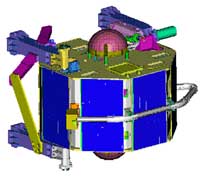Although small, the ST5 satellites were "full service," meaning they carried guidance, navigation and control, attitude control, propulsion, high bandwidth, and complex communication functions. Each performed some of the same functions as their larger counterparts. ST5's objective was to demonstrate and space-test the ability of "smart" satellites to identify scientific events and implement cooperative data-taking strategies.
The ST5 project also developed and built the spacecraft bus that enables the mission's multiple micro-sats to be launched from a single rocket and spun——like Frisbees—— into an elliptical Sun synchronous orbit ranging from 300 km (186 miles) to approximately 4,500 kilometers (2,796 miles) above Earth. The spinning motion was required to stabilize the spacecraft and allow for optimal use of sunlight by the solar array panels on the sides of the spacecraft.

|
ST5 satellite in launch rack, mag boom folded and spin mechanism cocked.
|
Once deployed, magnetometers onboard each of these miniaturized satellites measured energetic particles in the magnetosphere. Returned data will help reveal ambient radiation levels and the spacecrafts' subsystem response to this hazard.
Each micro-sat was commanded individually from ground stations on Earth, except for a one-week period of "lights out." During this time, the micro-sats flew "autonomously" with pre-programmed commands in a test to find out whether ground commanding (for 24 hours) is really necessary.
ST5's "maiden voyage" paved the way for flying tens to hundreds of such miniature craft in future missions. These missions can be flown only if they are capable of responding to the changes in the charged particles and magnetic fields in the harsh environment of Earth's magnetosphere.